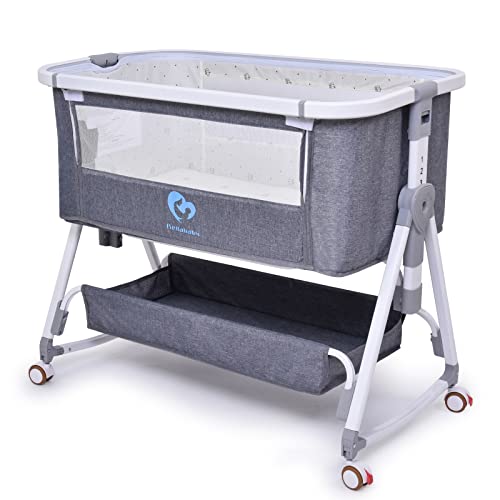The Importance of Bedside Cots for Infants: A Comprehensive Guide
As new parents start their parenting journey, they are faced with a myriad of options worrying their infant's sleep arrangements. Amongst these choices, the bedside cot stands out for its myriad of benefits. This post explores the significance of bedside cots, discusses their advantages and downsides, responses regularly asked concerns, and includes a relative table to help parents make informed decisions.
What Is a Bedside Cot?
A bedside cot is a sleep space designed to be put beside the parents' bed, enabling for easy access to the infant throughout the night. These cots include adjustable height settings, allowing them to align with the height of the adult bed. Typically, they can be connected securely to the bed or remain nearby, supplying a safe yet available sleep environment for the baby.
Kinds Of Bedside Cots
- Co-Sleeping Cots: These cots attach securely to the parents' bed, allowing for close distance while guaranteeing the baby has their own safe sleeping space.
- Freestanding Cots: These are located next to the bed but do not connect straight. They still use a convenient reach for feeding and soothing.
- Portable Cots: These cots are light-weight and created for travel, often featuring collapsible designs and easy-transport abilities.
Advantages of Using a Bedside Cot
Bedside cots supply numerous advantages that can boost both the infant's sleep experience and the parents' assurance. These include:
1. Improved Safety
According to the American Academy of Pediatrics (AAP), having the infant sleep in the very same room as parents, without sharing the exact same sleeping surface area, considerably lowers the risk of Sudden Infant Death Syndrome (SIDS). A bedside cot offers a safe space while maintaining distance.
2. Easier Nighttime Care
When a baby is within arm's reach, feeding, diaper modifications, and reassuring ends up being much more convenient. Parents can quickly soothe their infant without fully waking from sleep or leaving the bed.
3. Motivation of Bonding
The close proximity supplied by a bedside cot motivates bonding throughout nighttime feedings or reassuring. This can promote a complacency for the infant and assistance develop more powerful emotional connections.
4. Space-saving Design
Numerous bedside cots are designed to be compact, making them perfect for small living spaces where a full-sized crib may not fit. They can be quickly moved or kept when not in use.
5. Versatile Functionality
The majority of bedside cots can be adjusted in height and typically include detachable sides, making them versatile for different uses as the child grows or family needs modification.
Drawbacks of Bedside Cots
Regardless of their advantages, there are some downsides to consider when picking a bedside cot:
1. Minimal Lifespan
Bedside cots normally have a much shorter life-span than basic cribs, frequently accommodating infants only up to a particular weight or height. Parents might require to transition to a complete crib faster than prepared for.
2. Stability Concerns
If not securely attached or properly positioned, a bedside cot might present security concerns. Parents should guarantee that the cot is steady and well-aligned with the bed.
3. Adjustment Period
Some infants may take some time to get utilized to sleeping in a cot, especially if they are utilized to closer contact. Parents might require to be client as their kid adapts.
How to Choose the Right Bedside Cot
When selecting a bedside cot, parents must consider the following requirements:
- Safety Standards: Ensure the cot abides by all safety policies.
- Adjustability: Look for height-adjustable features that line up with your bed.
- Building and construction Material: Choose a cot that is strong and made from non-toxic materials.
- Reduce of Use: Opt for styles that enable for one-handed operation when accessing the infant.
Table: Comparison of Popular Bedside Cots
| Function | Co-Sleeping Cot | Freestanding Cot | Portable Cot |
|---|---|---|---|
| Attachment to Bed | Yes | No | No |
| Adjustability | Yes | Yes | Yes |
| Travel-Friendly | No | No | Yes |
| Life expectancy | 6-12 months | 18-24 months | 0-12 months |
| Rate Range | ₤ 150-₤ 300 | ₤ 100-₤ 250 | ₤ 50-₤ 150 |
Regularly Asked Questions (FAQs)
1. Are bedside cots safe for my baby?
Yes, when utilized correctly and according to safety standards, bedside cots are safe for infants. It is essential to make sure that the cot is firmly positioned and does not position any threat of falling.
2. At what age can I shift my baby from a bedside cot to a crib?
Most parents transition their baby from a bedside cot to a crib between six months and two years, depending on the infant's development and convenience level.
3. Can I use a bedside cot for twins?
While some bedside cots are created to accommodate more than one child, many are planned for single infants. Parents of twins might require to consider using different cots.
4. How do I maintain my bedside cot?
Regular cleaning, looking for wear and tear, and guaranteeing that all components, such as security straps and mattress, are in excellent condition, can help keep your bedside cot.
Selecting the right sleep arrangement for an infant is one of the many decisions that new parents face. Bedside Cot For Travel provides unequaled convenience and safety while permitting close parental interaction. Comprehending the benefits, disadvantages, and functions of bedside cots can empower parents to make the right option for their household's requirements. By weighing these aspects together with safety preventative measures, parents can develop a nurturing sleep environment for their little ones.

